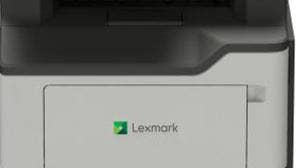Lexmark Channel Chief Kinlaw On New ‘Go Line’ Of SMB-Focused Printers And Why Partners Should Expect ‘More Opportunities To Earn More Dollars’

Ready. Set. Go.
Lexmark Vice President of Worldwide Channel and OEM Sales Sammy Kinlaw said Lexmark already had great products when he came on board eight months ago, but what was missing was a way for the channel to easily differentiate the products in the marketplace and quickly determine what pricing and incentives were in place.
His answer to that is the Lexmark Go Line, a new category name for products that are tailor-made for small businesses and come with built-in partner profitability. The line was developed to give partners an easy path to the best products, pricing, incentives and promotions for the SMB and open market categories, Kinlaw told CRN.
Since he took over channel sales at the Lexington, Ky.-based printer vendor, Kinlaw has sought to engineer a turnaround, not just in revenue, but in how the company approaches the channel. He said he’s seen success in the short time that he’s been on board.
“We’ve had a tremendous run for 2018, and we’re on target to make our numbers,” he said. “We’re going to finish the year growing above market.”
Here’s what Kinlaw had to say about those growth plans and and making sure they’re sustainable for the company and its partners.

What are you hoping to achieve by packaging already existing products as the Go Line?
The channel needed a way to recognize products on the shelf that were distinguished and focused on the SMB market. Much like Lenovo has Top Seller, or HP has Smart Buy, as an example, and Dell has their own line of channel-led, SMB-market-type products. Most major manufacturers do that. One of the first observations eight months ago, walking in the door, is Lexmark had started to go down that path but they only got halfway.
So over the course of the last six months, the brand team listened. That’s one thing I like about Lexmark. They want to do things that are valuable to the channel. I got the necessary support and they did that. So our new product category through the channel is designated as the ‘Go Line.’ I like Go Line because there’s lots of marketing collateral and campaigns that can be built around ‘On your mark, get set, go’ or ‘Ready. Set. Go.’ And ‘go’ indicates speed and ‘go’ indicates conditional formatting, that green light. There will be lots of things you can build around the Go Line and naming convention.
Now it’s up to us to make sure we’re fully trained and it’s served up on a silver platter for our distributors, so they can take it to the VAR community. But you can expect campaigns from us over the coming quarters, all built to serve Go. You can expect more incentives.

What can Lexmark channel partners expect through selling the Go Line? Can you talk about incentives?
I don’t want to publish details around it, other than I want to tell them they can make more money from it, the loyalty perks—that’s the way in which a VAR can be incented through us directly, through a debit card—we’re going to increase the amount that they can make on Go-type products.
You can expect more opportunities to earn more dollars. You can expect [volume incentive rebates] to be in place for larger partners who are going to see targets based on these type of products. This is a feature initiative. It’s built to simplify Lexmark’s go-to-market campaigns through the channel. I’m excited. It’s a way in which we’re going to keep marching to serve our channel partners for quarters to come.
This is going to be a way of life. This a rallying call for us to be more efficient with our channel partners. There was some confusion before. What to bid? Do they have to get a special bid? Do they not have to? This clarifies, for a certain type of end user, which product they should go with first.
I’m thrilled. It just goes back to the willingness of the company to grow in the channel. To me, walking in, having a channel background, it was one of the things, I said, ‘Hey you can’t grow, unless you do this.’ You have got to have products which a partner hears the name ‘Go Line’ and it resonates availability, and ‘I make more money.’ You miss that in our offerings. Its not that they didn’t have the right products created. Many of our new products fit beautifully in this category.

What products are included in the Go Line?
At a high level it begins with entry-level mono. Single function, and it scales all the way to multi-function, color, high page per minute. So really goes across the gamut of most of our product line. So it’s very wide and very deep. Lots of models involved.
It’s not like they had to develop new products. What they were missing or what the company needed to do, they needed to clarify which of all these products that we build are for the channel. So when a partner sees the Go Line, they know, this is the product I should be selling, because I’m selling to end users who are midmarket. Perhaps it’s not a complex rollout, perhaps they need 20 single-functions, mono, laser printers.
So, it’s a way they can easily distinguish and get pricing for their end user quickly. They know if they sell this, it’s on shelf at distribution, and secondly and even more importantly, they can make even more money selling this product. So it’s not rocket science. But we were missing a way to distinguish and categorize for our partners.

You had said in a May interview with us that Lexmark planned to rely heavily on your input for growing the company this year. How is that progressing?
I’m having a very good year. I’m having a very good year in North America. I’m having a very good year in the U.S. As you know, the printing market is declining. Well, I’m not declining. I’m growing. I’m growing at a premium for the market. We’re still finalizing numbers, but depending on the category within the channel, I grew from 7.5 percent to 10 percent year over year. The market declined, maybe a point. So. I’m growing at a significant premium to the market, and I’ve just scratched the surface. … I’ve had a good 2018. I’m going to have an even better 2019.
Is the growth that Lexmark is experiencing sustainable?
I have not bought the business. We have not done abnormal things to grow the business. This growth, above market, is from blocking, tackling, micromanaging the business, weekly cadences, meetings with our larger partners, trust with our distributors, being on stage more, getting our word out, taking advantage of the fact that 92 percent of the product line just turned over. All those little hits every day. It’s nowhere near done.

What are some of the changes Lexmark has made to create that growth?
The base of the pyramid for me is distribution. I’m a huge believer in the distribution model. Tech Data, Synnex, Ingram [Micro] have thousands of reps. They’re going to reach a much larger audience than I can on my own.
That being said, I did not have the right coverage model for VARs. Most of my field reps who were covering VARs were assigned too many accounts. We’re still a relatively small company. I knew I had to add bodies. So we built a sales center for sales reps and we’ve just hired 24 to focus on the VAR market for North America because in conjunction with all the investments we’re making, I need to get people to touch VARs. That was another thing I recognized right off the bat, joining the company. The company supported me, opened up the doors, so we have 24 reps covering that community now, where six months ago I had nobody.
It allows my field reps to move up the stack slightly to make sure I have the appropriate coverage. I have the distributors and I lean on them to increase the long tail of the channel, but I have to participate with them. I can’t ask them to do it alone. I asked the company to make the investment, and once again they believed in the effort, and where the channel needed to be with Lexmark and grow. They opened the checkbook and they built an inside sales team and they’re up and running.

How are are all these changes making Lexmark channel partners more productive?
I’ve built an on-boarding team, so if someone joins Lexmark as a new partner, I’ve got white-glove treatment to make sure they understand product, incentive, how they buy product, what are the processes within the world of Lexmark, how they use Partner Net—which is their access to our web information portal.
So all those are the things you do to build. It’s repeatable revenue. It’s sustainable. It’s not doing things out of the norm to buy the business in a quick hit. I want to build every-quarter growth. Sustainable quarter over quarter over quarter. I could grow many, many, many quarters sequentially.
I’m seeing it all over. My distribution is growing. I’m very pleased to tell you my VAR business is growing and when I first joined the company it was not growing. In a short amount of time we’ve been able to turn things around.
Are we where we want to be? No. Nowhere near it, but we’ve had a tremendous run for 2018, and we’re on target to make our numbers. We’re going to finish the year growing above market. I say that in not a boastful way at all. I don’t want it to be perceived that way, but I’m excited about it because it wasn’t happening when I joined. These changes that we’re making, the way that we’re administering the weekly cadence, and holding people accountable is working. We’ve seen a dramatic about-face—so new products, new coverage, new incentives, new category like Go Line that’s a great combination that we’ve built upon to start 2019.

How is Lexmark positioned for 2019?
I’ve got planning sessions right and left. I’m headed to Australia, week after that in EMEA, week after that I’m in Lexington [(Kentucky]. I’m making all these worldwide trips because I’m making sure we have the right plans for 2019. What are the other investments we need to make? What’s working? What’s not working? Those are the questions I’m asking. What processes do we need to refine? Are there go-bigger type investments that we need to make with select partners? Those are all things that I’m asking of our team, because I’ve got the support of our CEO and CFO and CRO to make strategic investments.